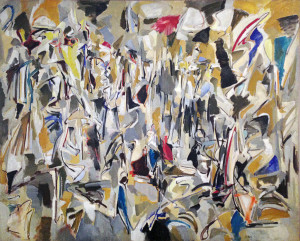255 Worth Avenue
Palm Beach, FL 33480
T 561.328.9504
Lisa@borghi.org
Post War Abstraction and the Influence of Hans Hofmann
April 1, 2016– May 31, 2016
-

Joan Mitchell (1926-1991) Untitled c. 1951-52 82 7/8 x 101 3/4 inches
Post War Abstraction and the Influence of Hans Hofmann
Among the most stunning works in the critically lauded Frank Stella retrospective at the Whitney Museum this fall are four wall sculptures — three-dimensional paintings, if you prefer — that revel in nautical themes inspired by Melville’s White Whale. Rejected by many when they were first shown in the 1990s, the Moby Dick series has grown in stature in recent years. There is no better way to appreciate these works than by understanding their aesthetic foudnations. Like many of the biggest names in Post-War American Art, Stella internalized the ideas of German-American painter and teacher Hans Hofmann. Go no further than Art Miami, as a part of 2 curated exhibitions, the first being Post War Abstraction and the influence of Hans Hofmann where a standout example from the Moby Dick series, “The Honor and Glory of Whaling,” by Frank Stella highlights the art and influence of Hofmann. Combining elements from a harpoon to a whale’s tail in a multi-tiered frenzy of post-Pop whimsy, the Stella work, says Mark Borghi, is nothing less than “Hofmann’s push-pull theory of spatial manipulation fully realized.” An emigrant from Germany not long before the Nazis seized power, Hofmann established himself as a teacher in the United States, bridging European Modernism and American Contemporary and shaping the styles of generations of artists, in and out of his classroom. This exhibition puts Hofmann side-by-side with students and admirers such as Willem de Kooning (a bright, layered canvas oozing confidence) and Helen Frankenthaler (an eruption of blood red recaller her teacher’s post- WWII palate), as well as those who absorbed Hofmann’s lessons from afar. Joan Mitchel, for example, attended Hofmann’s school for less than a week only to drop out because she was terrified of the man. And of course there’s Stella, who once called himself “a Hofmann student without knowing he was one.” While his reputation has been eclipsed by his students, Hofmann more than holds his own here. One painting from 1946 depicts a blood-red claw menacing a prostrate body as the Eiffel Tower looms in the distance. The result evokes the horrors of WWII while reminding us of a more recent tragedy; it’s title — “Fear” — is unnecessary to know it’s emotion. Times change: less than a decade later Hofmann was living in Berkeley, where he painted “Blue Arcata” in a more upbeat palate: rhythmic patterns of orange, yellow, and blue evoke warm, sunny skies.
